Simple Analog Components
Discrete analog components tend to be physically small because they’re fundamentally simple creations (see Figure 2.4). In the early days of electronics, all components were simple analog components. Since about 1960, engineers have been combining these discrete building blocks to create ever more elaborate, integrated components that tend to be physically larger.
Figure 2.4. These analog components, scattered across two silicon wafers, show the variety of s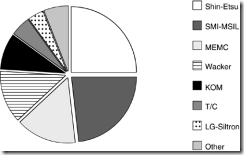
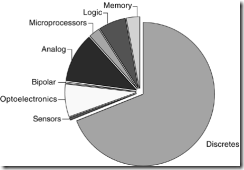
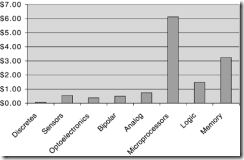
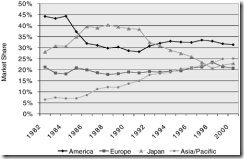

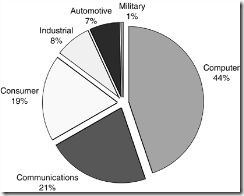
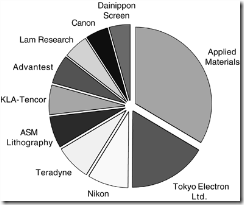
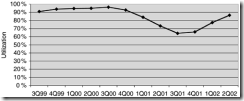
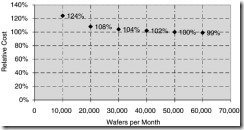
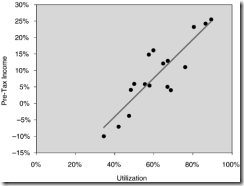
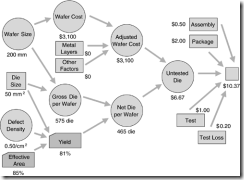
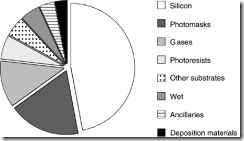 hapes and sizes these components can take. Courtesy of Texas Instruments. Used with permission.
hapes and sizes these components can take. Courtesy of Texas Instruments. Used with permission.

Some analog components are sold as small discrete components; others are combined into larger integrated analog components, seen later. Engineers designing analog products (e.g., radios and some stereo gear) sometimes like to fine-tune their designs by hand-picking each individual analog component. In contrast, engineers designing computers and other large digital products are happy to use ICs, taking their components in bulk. There’s a fair amount of finesse required to design and build complex products from discrete analog components, and engineers gifted with that talent are rare and valuable.
Resistors, capacitors, diodes, and other common analog discrete components are smaller than a penny and cost even less. These analog components are like the insects of the semiconductor world: They are amazingly plentiful and almost totally ignored.
You might sometimes hear electronics aficionados discussing linear components, especially if they’re into short-wave radios or high-end stereo gear. Linear components are a subclass of analog components. Some analog components are linear, and some are nonlinear. Linear describes how these components can take electricity and amplify (increase) or attenuate (decrease) it very smoothly without adding any “coloring” to it. In stereo gear, for example, it’s important to play the music exactly as it was recorded without adding artificial distortion.
Resistors
Let’s start our tour of the analog kingdom with resistors, probably the simplest and most common type of electrical component (see Figure 2.5). Resistors do pretty much what their name implies: They resist the passage of electricity. Resistors are electronic speed bumps, bleeding off voltage and slowing the electric flow.
Figure 2.5. Resistors are among the simplest electronic components. These three resistors are smaller than a pencil eraser and the wires on them are thinner than pencil lead. The colored stripes identify the amount of electrical resistance each resistor provides. Courtesy of Hitachi Semiconductor America. Used with permission.

Tech Talk
If you’re a fan of Newton’s Third Law of motion and Einstein’s E = mc2, you know that energy can’t be created or destroyed, only converted. Resistors convert the electricity they’re resisting into heat; the bigger the value of the resistor, the warmer it gets. Tiny resistors like those you’d find in a portable radio generate so little heat it’s not even noticeable. Some big resistors, though, need metal cooling fins to keep from overheating. In the extreme case, the whole purpose of a resistor is to generate heat. A car’s rear-window defogger or burners on an electric range are both examples of resistors that get hot on purpose.
Although slowing down electric current seems pretty pointless, clever combinations of resistors can adjust voltages to specific and desirable levels. Technically speaking, resistors aren’t really semiconductors because they’re not made from silicon. Most resistors are just powdered carbon stuffed into a hollow tube, like a tiny pencil. Big, high-voltage resistors use coils of heavy wire in place of the carbon, making them essentially electric space heaters.
Resistors are so small that it’s hard to print any markings on them, so they’re identified with colored bands. The colors are a special code that electrical engineers memorize early in their careers. Each color stands for a different number, from nine to zero: black, brown, red, orange, yellow, green, blue, violet, gray, and white.
Capacitors
The next-most common type of analog component is capacitors (see Figure 2.6). Again, the name gives you a hint about its function. Capacitors store small amounts of electricity, like electric shoeboxes. Electricity flows in one end of a capacitor, where it gets stored indefinitely or until the capacitor “overflows.” The bigger the capacity of a capacitor, the more electricity it holds until it overflows.
Figure 2.6. Capacitors have just two wires, like resistors. The larger “can” capacitors contain rolled-up foil and plastic in layers. The smaller capacitor uses a small amount of insulating material to separate its two wires. Courtesy of Hitachi Semiconductor America. Used with permission.

Capacitors are simply two metal plates separated by a small gap. Electricity can’t jump across this gap, so it builds up at one end of the capacitor. Finally, after enough electricity builds up on one side, the sheer force of all that juice pushes electricity away from the metal plate toward the other side. The net result is a brief time delay in the electric flow. If you’re used to repairing cars, you might remember replacing the condenser, which is just another word for capacitor. The condenser is a big capacitor that stores enough electricity to create a spark in the spark plugs.
Capacitors, like resistors, aren’t technically semiconductors because they aren’t made from silicon. Capacitors usually include two metal plates separated by a piece of plastic, paper, or sometimes just air. To make the capacitors small and compact the plates are wound up into a cylinder like cinnamon rolls.
Inductors
Inductors are peculiar components that take advantage of magnetic fields to control the flow of electricity. They are basically coils of very fine wire looped around and around a tiny central core. The whole inductor might be only as big as a pencil eraser, but it contains yards and yards of wire. They’re useful to engineers designing radio and cellular equipment, but inductors don’t show up much in computers and other digital products. From the outside, inductors look much like capacitors.
Transistors
Transistors are a major step up the evolutionary ladder from resistors, capacitors, diodes, and inductors. They’re also the first real semiconductor in our tour of the family tree. (Resistors, capacitors, and inductors are electronic components but they aren’t made from semiconducting materials.) The invention of the transistor in 1947 was a landmark event in semiconductor physics. Transistors changed the way electronic systems are built and paved the way for everything from transistor radios to microprocessors.
Transistors were once called valves, which is a pretty fair description of what they do. A transistor, like a water valve or a spigot, has a place where current flows in, a place where it flows out, and some way to control the flow. Electrically speaking, transistors adjust the “water pressure” of a flowing electric current. They allow one electrical circuit to control another, like hands on valves. You’ll find more discussion of how transistors work in Chapter 9, “Theory.”
Like a water valve, transistors can adjust the flow of electricity in variable amounts. This makes them analog components because they adjust electricity in a continuous stream. Also like a valve, transistors can turn the flow on or off completely, which would make them digital components. The fact is, they’re both. Transistors bridge the gap between analog and digital. They can be used like analog components, smoothly adjusting electrical flow, or they can be used as digital components, acting as on/off switches.
Figure 2.7 shows the first transistor ever made. The electricity flows in through the curly wire on the left and flows out through the wire on the right. The thick wire in the middle controls the flow; it’s the hand on the spigot. The triangular object attached to the wires is a chunk of semiconducting material. In this case, it’s not silicon but a different natural material called germanium. After some experimentation, silicon was found to be a better material and virtually all semiconductors today are made from silicon.
Figure 2.7. The first semiconductor transistor, created in 1947 by John Bardeen, Walter Brattain, and William Shockley while working for Bell Laboratories. Courtesy of Lucent Technologies. Used with permission.